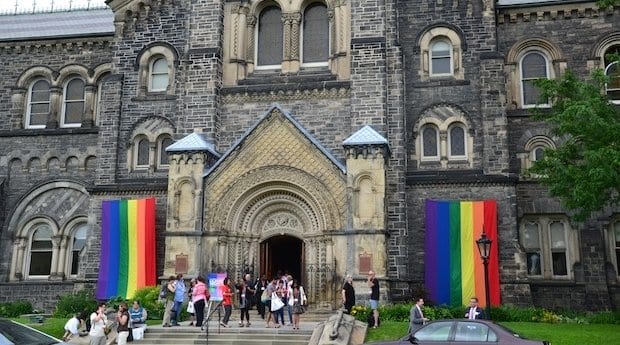Getting people to use condoms can be tricky. Getting them to use them consistently and correctly can be even tougher, and the issue is complicated even further when you factor in cultural differences and the lingering stigma against people living with HIV/AIDS still present in many communities.
A June 25 panel discussion at the 2014 WorldPride Human Rights Conference in Toronto examined the issue and some of its more nuanced aspects, with a focus on ethno-cultural approaches to health and harm reduction.
Rodney Rousseau, a researcher studying HIV immunology at the University of Toronto, spoke about the effect stigmatization has on research practices. Rousseau is also a member of the Global Network of People Living with HIV (North America) and a steering committee member of AIDS Action Now.
At the panel, he explained how in countries such as Uganda and Kenya, where sex between men is illegal, great care must be taken to preserve the identities of anyone who agrees to participate in research studies. If research facilities are raided, as can sometimes happen, any individuals who are identified can face persecution and punishment at the hands of their governments.
Presenter Warren Greene, a support worker at the Ontario Aboriginal HIV/AIDS Strategy and a two-spirit gay man, spoke about his role as a teacher in his community. When educators honour and embrace culture, he said, communities can be taught about safer sex and harm reduction in ways they are likelier to engage with.
“We want to be intimate with one another,” said Greene, who also works with homeless youth and HIV-positive men in the prison system. He explained how in aboriginal culture, sex is the most intimate form of one-on-one communication between people and isn’t seen as shameful. He also spoke about the importance of including people of all ages in safer-sex education.
Activist Charles Salil, who works in HIV prevention among men who have sex with men in Kenya, spoke about how the major issue in many African countries is the stigmatization that prevents people from accessing medical care. “There’s a problem in Africa in general,” he said. “You know it’s happening in countries in Africa.”
Salil said that while condoms are not necessarily difficult to access in Kenya, the stigmas that exist often prevent people from using them. As well, he said, HIV-positive men in rural areas tend to become outcasts, which further restricts their access to safer-sex methods and education.
François Zarraga, a French Canadian two-spirit educator and activist who works with the Bureau régional d’action sida (BRAS) in Gatineau, was in the audience at the panel. He said safer-sex practices are a big problem in the Ottawa-Gatineau region, particularly among people who come from out of town to attend conferences.
Zarraga got involved with HIV/AIDS activism after seeing its effects firsthand in his community. “Being part of the gay community in Ottawa-Gatineau, you lose a lot of friends to HIV,” he said. “It just made me more enticed to get involved in the community in that aspect.”
He said the panel helped him to understand some of the different cultural stigmas that still exist against HIV and hopes that what he learned will help him continue to educate others. “It is relevant because of all the cultures in the community itself,” he said. “There’s different mentalities in the cultures.”
Carleton University political science student Arun Smith also attended the panel, saying he found its focus on HIV/AIDS on an international scale, as opposed to just in Western countries, to be particularly enlightening.
“The reality of people living with HIV/AIDS is complicated by the multiple intersectionalities of their identities,” Smith said. “These are a lot of the conversations that sort of get subsumed — we talk about HIV/AIDS as if it’s something that affects men who have sex with men, period.”
Smith also points to the importance of considering queer culture as part of the safer-sex conversation and of not automatically stigmatizing those who make choices to escape heteronormative assimilation.
“While looking at ethnocultural communities and indigenous communities is vital, we also have to look at queer communities and how diverse those are,” he said. “It’s never going to be as simple as condom use. It’s never going to be as simple as, you know, ‘Do this, ergo this will not happen.’ It has to be a much bigger conversation.”


 Why you can trust Xtra
Why you can trust Xtra


